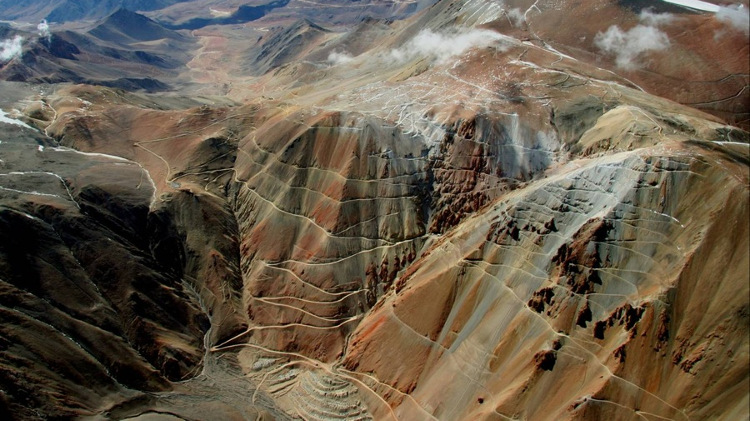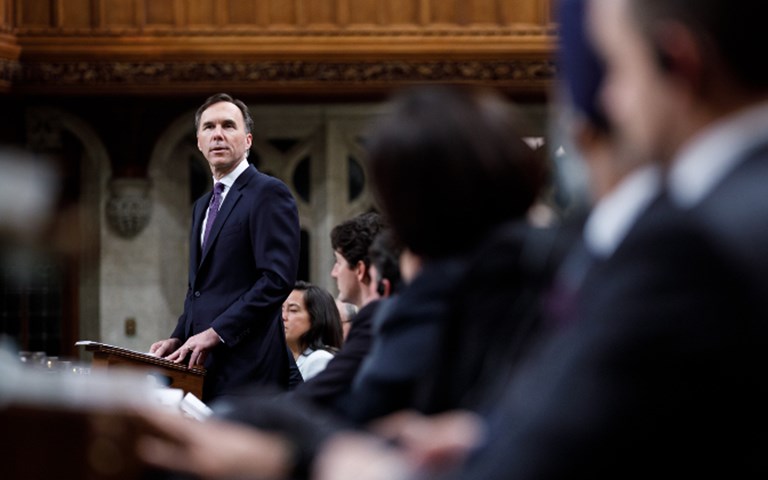Minister of Finance Bill Morneau tabled the 2018 federal budget in the House of Commons on Feb. 27. Courtesy of the Office of the Prime Minister of Canada
Skills and employment training for Indigenous Canadians, a pilot apprenticeship grant for women pursuing careers in the trades and a one-year extension of the Mineral Exploration Tax Credit (METC) are a few of the initiatives in the 2018 federal budget being praised by industry groups.
But both the Mining Association of Canada (MAC) and the Prospectors and Developers Association of Canada (PDAC) said the budget did not go far enough to help the Canadian mining industry compete globally.
The budget “does little to enhance Canada’s competitiveness at a time when the country’s relative share of exploration spending and new mine investment has been declining,” said MAC CEO Pierre Gratton in a release, “and as our major trading partner, the United States, has significantly reduced corporate and personal income tax.”
PDAC president Glenn Mullan agreed, saying in a release that while Canada is a mining leader, “on an international scale it has become increasingly less competitive.”
According to S&P Global Market Intelligence’s March 2017 report on global mining exploration trends, spending on gold exploration in Canada declined to US$487.2 million in 2016, a nearly US$110 million drop from the year before. And for the first time since 2003 Australia overtook Canada as the top gold exploration destination in the world, with US$510 million spent there in 2016. However, S&P pointed out that Canada was the “most popular national target” for exploration spending, accounting for 14 per cent of the global total.
The budget did not earmark much specifically for the mining industry, but did renew the METC, a 15 per cent non-refundable tax credit that incentivizes investment in junior exploration companies, until March 31, 2019. Both associations cheered the renewal, but have in the past called for three-year extensions.
“Renewing the METC for one year helps our members in the short term,” Mullan said. “Yet greater measures are required – both by government and industry – if Canada’s mineral exploration and development sector is to remain globally competitive.”
Related: Can innovative geoscience reverse the trend of declining discovery?
The industry will likely also benefit from the new Indigenous Skills and Employment Training Program (ISET), which will replace the existing Aboriginal Skills and Employment Training Strategy. The federal government earmarked $2 billion over five years for the new program, which will have a stronger focus on “training for higher-quality, better paying jobs rather than rapid re-employment.” The program will also support services like childcare, to give Indigenous women better access to skills and training.
The government also plans to pilot an apprenticeship incentive grant for women, which will put $19.9 million over five years toward encouraging women to pursue careers in the trades. Women in Red Seal trades, which include heavy equipment operators of dozers, excavators and tractor/loader/backhoes, will receive $3,000 per year in their first two years of training.
MAC said it “welcomes” the two measures “focused on efforts to enhance workforce diversity.” According to a 2015 report from the Mining Industry Human Resources Council (MiHR), women only make up 17 per cent of the Canadian mining industry, representing 38,600 positions.
The budget lays out $1 billion in funding for implementing the new Impact Assessment Agency and the Canadian Energy Regulator, and also details funding for several of the federal government’s initiatives to combat climate change. The Canadian Revenue Agency and Environment and Climate Change Canada will receive $109 million over five years to put in place, administer and enforce the government’s carbon pricing backstop plan. The environment ministry will also receive $20 million over the same timeframe to hire external experts to evaluate the effectiveness of the Pan-Canadian Framework on Clean Growth and Climate Change, which all provinces but Saskatchewan have signed on to.
The government placed a heavy focus on scientific research and innovation in the budget, which the mining and mineral exploration sectors may benefit from. Canada’s granting councils and research institutes will receive $1.7 billion over five years, including the Natural Sciences and Engineering Research Council, which will get $354.7 million, to “support the next generation of Canadian researchers.” The government will also spend $1.3 billion over the same time frame on laboratories, equipment and other research infrastructure.
The Canada Research Chairs program will also get a funding boost, with $210 million to support researchers earlier in their careers and attempt to increase diversity – specifically the number of women – among the nominated researchers.
British Columbia’s Association for Mineral Exploration (AME) said it was pleased with the increase in research funding in a news release. “We hope to see increased investment in resource-related science and technology, particularly in geoscience and mineral exploration, in support of the discovery of new mineral resources and their responsible development,” said AME board chair Lyn Anglin.
The budget also put an emphasis on interdisciplinary research with two new proposed funding initiatives. It is allocating $2.8 billion to creating a multi-purpose and collaborative research group that will bring together scientists and facilities from the Agriculture and Agrifood, Natural Resources, Fisheries and Oceans and Environment and Climate Change ministries, the National Research Council and others to “advance interdisciplinary research on, among other things, climate change, ocean protection and human health.”
It also put $275 million toward creating a new tri-council fund for NSERC, the Canadian Institutes of Health Research (CIHR) and the Social Sciences and Humanities Research Council (SSHRC) to support “international, interdisciplinary, fast-breaking and higher-risk” research.



